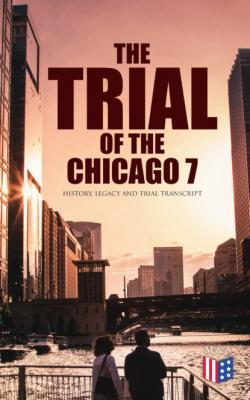ТОП просматриваемых книг сайта:
The Trial of the Chicago 7: History, Legacy and Trial Transcript. Bruce A. Ragsdale
Читать онлайн.Название The Trial of the Chicago 7: History, Legacy and Trial Transcript
Год выпуска 0
isbn 4064066383282
Автор произведения Bruce A. Ragsdale
Жанр Документальная литература
Издательство Bookwire
Bruce A. Ragsdale, Federal Judicial Center
The Trial of the Chicago 7: History, Legacy and Trial Transcript
Madison & Adams Press, 2021
Contact: [email protected]
EAN 4064066383282
This is a publication of Madison & Adams Press. Our production consists of thoroughly prepared educational & informative editions: Advice & How-To Books, Encyclopedias, Law Anthologies, Declassified Documents, Legal & Criminal Files, Historical Books, Scientific & Medical Publications, Technical Handbooks and Manuals. All our publications are meticulously edited and formatted to the highest digital standard. The main goal of Madison & Adams Press is to make all informative books and records accessible to everyone in a high quality digital and print form.
Table of Contents
The Chicago Conspiracy Trial: A Short Narrative
The Judicial Process: A Chronology
The Federal Courts and Their Jurisdiction
Legal Questions Before the Federal Courts
Media Coverage and Public Debates
The Official Trial Transcript – The Crucial Parts
The Chicago Conspiracy Trial: A Short Narrative
The trial of political activists accused of inciting riots during the Democratic National Convention of 1968 attracted national attention and exposed the depths of political and cultural divisions at a crucial moment in the nation’s history. The trial of the “Chicago Seven” became a defining event in public debates about the Vietnam War, the student protest movement, and the fairness of the federal judicial process.
The defendants and their lawyers used the courtroom as a platform for a broad critique of American society and an almost anarchic challenge to the legitimacy of governmental authority. The judge in the case displayed open contempt for the defendants, and his own unorthodox behavior threatened public confidence in the judiciary. The nearly five-month long trial illustrated the contentious and often theatrical nature of public affairs during the late 1960s and early 1970s.
Table of Contents
Planning for the Democratic National Convention of 1968
Organizing protests at the Democratic convention
Planning for the Democratic National Convention of 1968
In the fall of 1967, the Democratic Party decided to hold its 1968 national convention and the expected renomination of President Lyndon Johnson in Chicago. Mayor Richard Daley promised his city would be free of the civil disorders that had broken out in major cities in recent summers. By the summer of 1968, the prospects for a smooth convention had vanished. Johnson, in the face of growing protests against the Vietnam War and alter assessing the surprising strength of Eugene McCarthy’s campaign for President, withdrew in March from the race for the nomination. The assassination of Martin Luther King in April provoked devastating urban riots in Chicago and other cities. The assassination of Robert Kennedy in June further shocked the nation and complicated the race for the Democratic nomination. The spring of 1968 had also brought the Tet offensive against American forces in Vietnam and unprecedented student protests on university campuses. By August, many Americans believed the nation was in the midst of a profound political and cultural crisis.
Organizing protests at the Democratic convention
In the fall of 1967, members of the National Mobilization Committee to End the War in Vietnam proposed a massive anti-war demonstration to coincide with the expected renomination of President Johnson in Chicago. The National Mobilization Committee was directed by David Dellinger, a long-time pacifist, who had organized the march on the Pentagon in October 1967. In early 1968, the National Mobilization opened a Chicago office directed by Rennie Davis and Tom Hayden, who were leading political organizers and former leaders of Students for a Democratic Society.
A small group of cultural radicals, including Jerry Rubin, who helped Dellinger organize the march on the Pentagon, and Abbie Hoffman, an organizer of political theater events, planned a “Festival of Life” to counter the Democratic “Convention of Death.” Rubin and Hoffman dubbed themselves the Yippie movement, later explained as an acronym for the Youth International Party. They planned outdoor concerts, nonviolent self-defense classes, guerrilla theater, and a “nude-in” on a Chicago beach.
In March, representatives of various left-wing and radical student groups met in Lake Villa,

